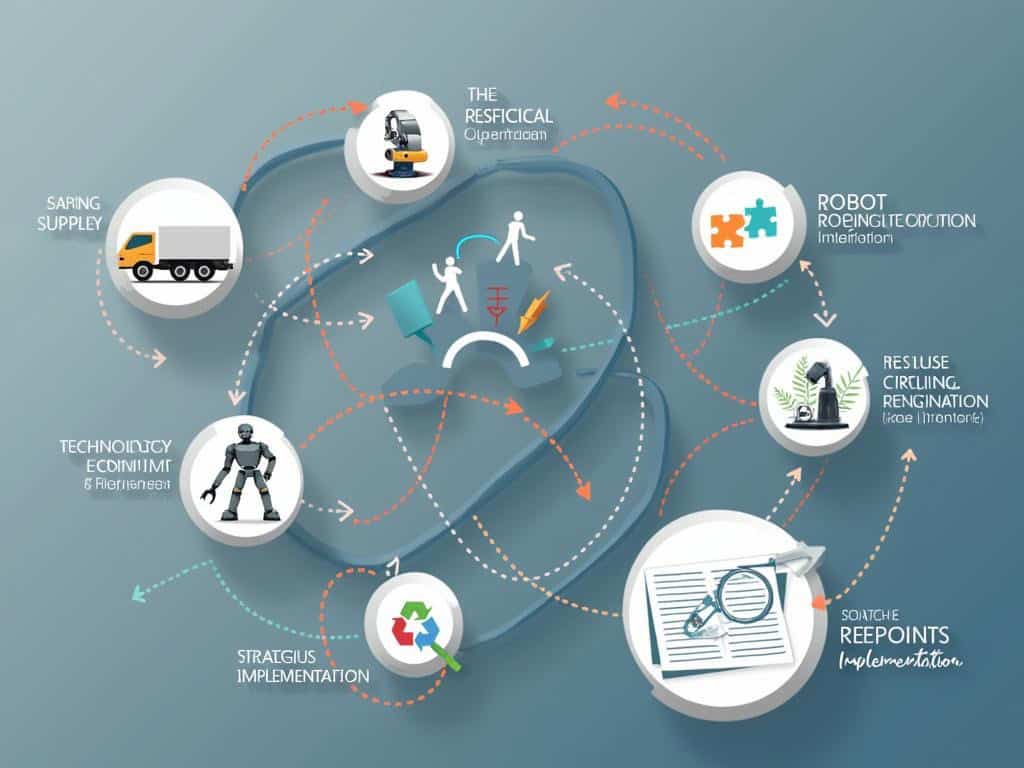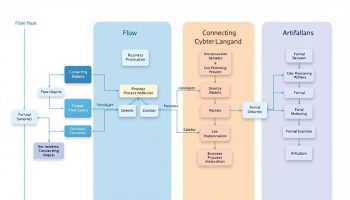
Six Powerful Supply Chain Strategies for Business Success
In today’s fast-paced business environment, six supply chain strategies stand out as essential tools for boosting organizational performance and resilience: efficient flow, AI and automation, resilience through diversification, sustainability and circular economy integration, technology-enabled visibility, and strategic implementation. These connected approaches give businesses comprehensive frameworks to optimize operations, cut risks, improve efficiency, and adapt to quickly changing market conditions.
Key Takeaways:
- The six supply chain strategies focus on creating streamlined, technologically advanced, and adaptable supply chain networks.
- Each strategy addresses different aspects of supply chain management, from operational efficiency to technological innovation.
- Successful implementation requires a holistic approach that integrates technological solutions with strategic planning.
- Companies can achieve significant performance improvements, including cost reductions and increased operational resilience.
- Continuous adaptation and regular strategy review are essential for maintaining competitive advantage in evolving business environments.
Efficient Flow: Optimizing Your Supply Chain Operations
Creating an efficient flow throughout your supply chain requires eliminating bottlenecks and reducing waste. This strategy focuses on streamlining processes from raw material sourcing to final product delivery. Companies implementing efficient supply chain flows typically see reduced inventory costs and faster delivery times.
Lean management principles play a crucial role in this strategy. You’ll benefit from implementing just-in-time inventory systems that minimize storage costs while ensuring materials arrive exactly when needed.
Data analytics helps identify inefficiencies and opportunities for improvement. Your organization should establish clear metrics for measuring performance across the supply chain, allowing for continuous refinement of processes.
AI and Automation: Transforming Supply Chain Management
Artificial intelligence and automation revolutionize traditional supply chain operations. These technologies enable predictive analytics, autonomous decision-making, and enhanced forecasting accuracy.
Implementing AI-powered demand forecasting reduces excess inventory and prevents stockouts. Your business can respond more quickly to market changes with automated systems that adjust orders and production schedules based on real-time data.
Robotic process automation (RPA) streamlines repetitive tasks, freeing your team to focus on strategic initiatives. This leads to reduced operational costs and fewer human errors in routine processes.
Resilience Through Diversification: Mitigating Supply Chain Risks
Building resilience requires diversifying suppliers, production facilities, and distribution channels. This strategy protects your operations from disruptions caused by natural disasters, political instability, or supplier failures.
Geographic diversification reduces vulnerability to regional disruptions. Your business becomes more adaptable when you maintain relationships with suppliers in different locations.
Alternative sourcing strategies help maintain continuity during disruptions. Developing contingency plans for critical components ensures your operations can continue even when primary suppliers face challenges.
Regular risk assessments identify potential vulnerabilities before they cause problems. Your team should conduct scenario planning exercises to prepare response strategies for various disruption types.
Sustainability and Circular Economy Integration
Incorporating sustainability into your supply chain goes beyond environmental responsibility—it delivers long-term business value. Circular economy principles reduce waste and create new revenue opportunities through product reuse and recycling.
Sustainable sourcing practices improve brand reputation and meet growing consumer demands. Your company can gain competitive advantage by documenting and marketing responsible procurement policies.
Waste reduction initiatives lower costs while minimizing environmental impact. Redesigning products and packaging for reuse or recycling creates both environmental and economic benefits.
Carbon footprint reduction addresses regulatory requirements and consumer expectations. Your business should implement measurement systems to track and report progress on sustainability goals.
Technology-Enabled Visibility: Gaining End-to-End Insights
Complete supply chain visibility enables proactive management and faster problem resolution. Modern technologies provide unprecedented transparency into every aspect of your operations.
IoT sensors and RFID tracking deliver real-time location and condition information. Your team gains immediate alerts about delays or quality issues before they escalate into major problems.
Blockchain technology enhances supply chain transparency and traceability. This helps your business verify product authenticity and quickly identify sources of contamination or defects.
Advanced analytics transform raw data into actionable insights. Your organization can identify patterns and trends that might otherwise remain hidden, leading to more informed decision-making.
Strategic Implementation: Turning Theory into Practice
Successful strategy implementation requires careful planning and organizational alignment. This includes securing leadership support, allocating adequate resources, and establishing clear performance metrics.
Cross-functional teams drive more effective implementation. Your supply chain initiatives succeed when they incorporate perspectives from across the organization.
Phased implementation reduces disruption and allows for adjustments. Starting with pilot projects helps your team refine approaches before full-scale deployment.
Continuous improvement mechanisms ensure strategies evolve with changing conditions. Your business should establish regular review processes to evaluate performance and make necessary adjustments.
By implementing these six strategies, your organization can create a supply chain that delivers competitive advantage through improved efficiency, enhanced resilience, and greater sustainability. The integration of these approaches provides a comprehensive framework for supply chain excellence in today’s challenging business environment.
“In today’s fast-paced business world, the integration of six key supply chain strategies empowers organizations to enhance efficiency, resilience, and adaptability. By embracing technological innovation and a holistic approach to strategy, companies can navigate change and unlock significant performance improvements.”
Efficient Flow Strategy: Lean and Synchronized Operations
The efficient flow strategy focuses on creating streamlined supply chain operations in steady, predictable demand environments. This is one of the six supply chain strategies that can dramatically improve your operational performance while reducing costs. By minimizing waste and excess inventory, you’ll create a more responsive and cost-effective supply chain network.
Strong vendor collaboration forms the backbone of this strategy. You’ll need precise demand forecasting to ensure materials arrive just when needed. Toyota’s lean manufacturing serves as the benchmark model for these six supply chain strategies, demonstrating how synchronized operations can transform productivity.
Key Implementation Components
Implementing efficient flow requires focused attention on several critical elements. You’ll need to prioritize these six supply chain strategies components:
- Inventory reduction through just-in-time practices
- Elimination of non-value-adding physical movements
- Development of collaborative supplier relationships
- Implementation of pull-based production systems
- Standardization of work processes across operations
The efficient flow approach delivers measurable benefits when implemented correctly. A well-executed lean strategy can help you reduce inventory costs by 20-30% while improving operational efficiency by 15-25%.
A critical component of efficient flow is process improvement in your supply chain operations. By consistently analyzing workflows, you’ll identify bottlenecks that impede your progress toward optimization.
Effective implementation of these six supply chain strategies requires careful strategic planning. You’ll need to establish clear metrics to track performance improvements as you streamline operations.
| Benefit Area | Traditional Approach | Efficient Flow Strategy |
|---|---|---|
| Inventory Levels | High safety stock | Minimal buffer inventory |
| Production Cycles | Large batch sizes | Small, frequent runs |
| Quality Control | End-of-line inspection | Built-in quality checks |
| Supplier Relations | Transactional | Collaborative partnerships |
Your ability to synchronize operations depends heavily on reliable data. Implementing database analytics will provide the insights needed to fine-tune your supply chain performance.
When developing these six supply chain strategies, consider how they align with your broader strategic vision. The efficient flow approach works best when integrated into your organization’s overall business objectives.

AI and Automation: Transforming Supply Chain Intelligence
AI and automation are revolutionizing how you manage supply chains, representing one of the most impactful six supply chain strategies available today. These technologies aren’t just enhancing existing processes—they’re fundamentally transforming how decisions are made and operations are executed.
The impact of implementing these six supply chain strategies, particularly AI solutions, is substantial. AI can reduce prediction errors by 20-50%, significantly improving forecasting accuracy. This enhanced precision helps cut inventory overstocking by 20-50% while simultaneously decreasing sales losses by up to 65%.
When properly deployed, these six supply chain strategies centered around technology can deliver measurable improvements across your operation:
- Logistics costs typically see a 15% reduction
- Inventory levels experience 35% optimization
- Service levels enjoy a 65% enhancement
Key Technologies Driving Transformation
The foundation of this transformation rests on several critical technologies that form the backbone of modern six supply chain strategies:
- Predictive analytics that anticipate demand fluctuations
- Warehouse robotics automating physical tasks
- Machine learning systems that continuously optimize routing
- Computer vision for quality control and inventory management
- Natural language processing for supplier communication enhancement
A comprehensive approach to project communication becomes essential when implementing these technologies. The integration of these tools requires careful strategic planning to ensure alignment with business objectives.
| Challenge | AI/Automation Solution | Expected Benefit |
|---|---|---|
| Demand forecasting | Predictive analytics | 20-50% reduction in prediction errors |
| Inventory management | AI-powered stock optimization | 20-50% decrease in overstocking |
| Order fulfillment | Warehouse robotics | 30% increase in picking speed |
| Transportation | Route optimization algorithms | 15% reduction in logistics costs |
| Quality control | Computer vision systems | 40% faster defect detection |
For successful implementation, you’ll need to develop a clear roadblock mitigation plan that addresses potential integration challenges. This preparation will help you maximize the benefits of these six supply chain strategies while minimizing disruption during the transition period.

Resilience through Diversification and Strategic Buffering
Supply chain disruptions have become increasingly common, prompting 78% of companies to adopt inventory buffering strategies as one of the six supply chain strategies for business continuity. You can strengthen your operations by implementing strategic buffers and diversifying your supplier base to withstand market volatility and unexpected disruptions.
Building Robust Supply Networks
Developing multiple supplier relationships is crucial when implementing the six supply chain strategies focused on resilience. This approach allows you to quickly pivot when one supplier faces challenges. Instead of relying on a single source, you’ll have alternatives ready to step in during emergencies.
Strategic buffering involves maintaining calculated inventory reserves of critical components. This isn’t about reverting to excessive inventory practices but strategically identifying which materials warrant safety stock. When determining optimal buffer levels, consider:
- Lead time variability from different suppliers
- Historical disruption patterns in your industry
- Criticality of components to your production schedule
- Storage costs versus stockout risks
A comprehensive risk management approach is essential for implementing these six supply chain strategies effectively. You should regularly assess vulnerabilities across your entire supply network and develop effective risk response plans for various scenarios.
For maximum effectiveness, combine your diversification efforts with supply chain process improvements. This integration ensures you’re not just adding redundancy but also enhancing overall efficiency. The most successful companies don’t view the six supply chain strategies as isolated initiatives but as interconnected approaches that strengthen each other.
| Resilience Strategy | Implementation Approach | Expected Outcome |
|---|---|---|
| Supplier Diversification | Develop relationships with multiple vendors in different regions | Reduced single-source dependency |
| Strategic Buffering | Maintain calculated safety stock for critical items | Continuity during supply disruptions |
| Geographic Distribution | Spread production and storage facilities across regions | Localized disruption containment |
| Risk Monitoring | Implement early warning systems for supply chain threats | Proactive response capabilities |
With these six supply chain strategies focused on resilience, you’ll be better positioned to maintain operations during disruptions while competitors struggle to adapt. Remember that resilience isn’t just about surviving disruptions—it’s about maintaining service levels and customer satisfaction even during challenging times.

Sustainability and Circular Economy Integration
Implementing eco-friendly practices in your supply chain isn’t just good for the planet—it’s one of the six supply chain strategies that can significantly boost your bottom line. Companies that integrate sustainability principles are seeing enhanced brand reputation and increased customer loyalty while simultaneously reducing operational costs.
Nearshoring and friend-shoring have emerged as critical strategies for businesses looking to reduce carbon footprints. By moving production closer to end markets, you’ll cut transportation emissions while improving response times to market changes. This approach also helps you avoid geopolitical risks that have disrupted global supply chains in recent years.
Key Circular Economy Practices
Circular economy principles transform traditional linear supply chains into regenerative systems. Here are essential strategies that embrace circularity:
- Product design for disassembly and recycling
- Reverse logistics systems for product returns and recycling
- Waste-to-resource conversion processes
- Remanufacturing of used components
- Resource sharing across supply chain partners
- Extended producer responsibility programs
These circular economy practices help you create a competitive advantage through reduced raw material costs and waste management expenses. When you implement these strategies correctly, you’ll see measurable improvements in resource efficiency while meeting growing consumer demands for environmental responsibility.
The following table demonstrates the business benefits of implementing sustainable supply chain strategies:
| Sustainability Strategy | Business Impact | Environmental Benefit |
|---|---|---|
| Emissions reduction | Lower fuel costs | Reduced carbon footprint |
| Packaging optimization | Decreased material costs | Less waste to landfill |
| Renewable energy adoption | Energy cost stability | Lower greenhouse gas emissions |
| Water conservation | Reduced utility expenses | Protected water resources |
| Circular material flows | New revenue streams | Decreased resource depletion |
Your journey toward sustainability should include strategic review processes to regularly evaluate performance against environmental targets. By incorporating process improvement in supply chain operations, you’ll continuously enhance both sustainability outcomes and operational efficiency.
Establishing strategies focused on sustainability requires collaboration across your organization. You’ll need to engage in project collaboration with suppliers, logistics partners, and even competitors to create truly circular systems that maximize resource use and minimize environmental impact.
According to a recent study, companies that prioritize circular economy practices can achieve a 20-30% reduction in operational costs while enhancing their sustainability credentials.
forbes.com
Technology-Enabled Supply Chain Visibility
Digital transformation has revolutionized how you manage supply chain operations. Implementing the right six supply chain strategies can dramatically improve visibility across your entire network. Today’s technology solutions offer unprecedented transparency that can transform decision-making capabilities and customer satisfaction levels.
Key Technologies Driving Supply Chain Visibility
IoT sensors, blockchain solutions, and real-time monitoring systems form the backbone of modern supply chain visibility. These technologies enable you to track products throughout their journey with precision previously impossible. When you implement these six supply chain strategies effectively, you’ll gain comprehensive insights into inventory levels, shipment locations, and potential disruptions.
Real-time data access allows you to make faster, more informed decisions when facing unexpected challenges. By investing in these six supply chain strategies focused on visibility, you can identify bottlenecks before they impact operations. This technological approach enhances your ability to respond effectively to risks and maintain service levels even during disruptions.
The benefits of technology-enabled visibility extend beyond operational improvements. Your customers gain confidence through accurate delivery estimates and product tracking capabilities. This transparency builds trust and strengthens relationships with key stakeholders. When properly implemented, these six supply chain strategies create a competitive advantage through superior service delivery.
Blockchain technology deserves special attention as it creates immutable records of every transaction across your supply chain. This capability is particularly valuable for industries requiring strict compliance documentation or product authenticity verification. The distributed nature of blockchain makes it an ideal component of the six supply chain strategies focused on end-to-end visibility.
For maximum impact, integrate these visibility technologies with your existing strategic planning processes. This integration ensures that the data collected drives meaningful improvements rather than creating information overload. The most successful implementations of these six supply chain strategies align technology investments with specific business objectives.
Strategic Implementation and Future Outlook
The implementation of six supply chain strategies requires a thoughtful approach tailored to your organization’s specific needs and market positioning. Your success depends on how effectively you combine these strategies while maintaining alignment with broader business objectives.
Integration Framework for Six Supply Chain Strategies
When implementing these six supply chain strategies, you’ll need to balance immediate operational needs with long-term resilience goals. Start by assessing your current capabilities against each strategy to identify gaps and opportunities. This comprehensive approach helps you develop strategic planning that encompasses all dimensions of supply chain excellence.
Here’s how you can prioritize implementation of the six supply chain strategies:
- Conduct a maturity assessment for each strategy area
- Identify quick wins that deliver immediate value
- Develop phased implementation roadmaps
- Establish clear metrics and measurement frameworks
- Create cross-functional teams to drive adoption
Technology serves as the foundation for modern supply chain transformation. You’ll need robust data analytics capabilities to support decision-making across these six supply chain strategies. Project implementation should focus on systems that enable end-to-end visibility and analytics.
| Strategy | Key Technology Enablers | Expected Benefits |
|---|---|---|
| Efficient Flow | Advanced planning systems, IoT sensors | 15-20% inventory reduction |
| AI & Automation | Machine learning, robotics, predictive analytics | 30-40% forecasting improvement |
| Resilience | Risk monitoring tools, simulation software | 50% faster disruption response |
| Sustainability | Carbon tracking, circular economy platforms | 25% emissions reduction |
| Visibility | Blockchain, control towers, real-time dashboards | 60% improvement in traceability |
| Strategic Integration | Cloud-based collaboration platforms | 35% better cross-functional alignment |
Future success requires continual adaptation of these six supply chain strategies as market conditions evolve. You should establish formal review processes to assess strategy performance and make necessary adjustments. Continuous improvement becomes essential as you refine your approach based on lessons learned.
Remember that successful implementation of six supply chain strategies demands executive sponsorship and organizational buy-in. You’ll need to communicate both the business case and progress regularly to stakeholders across the organization.






